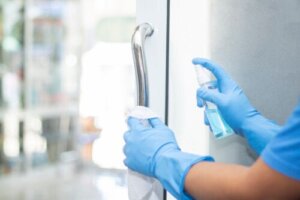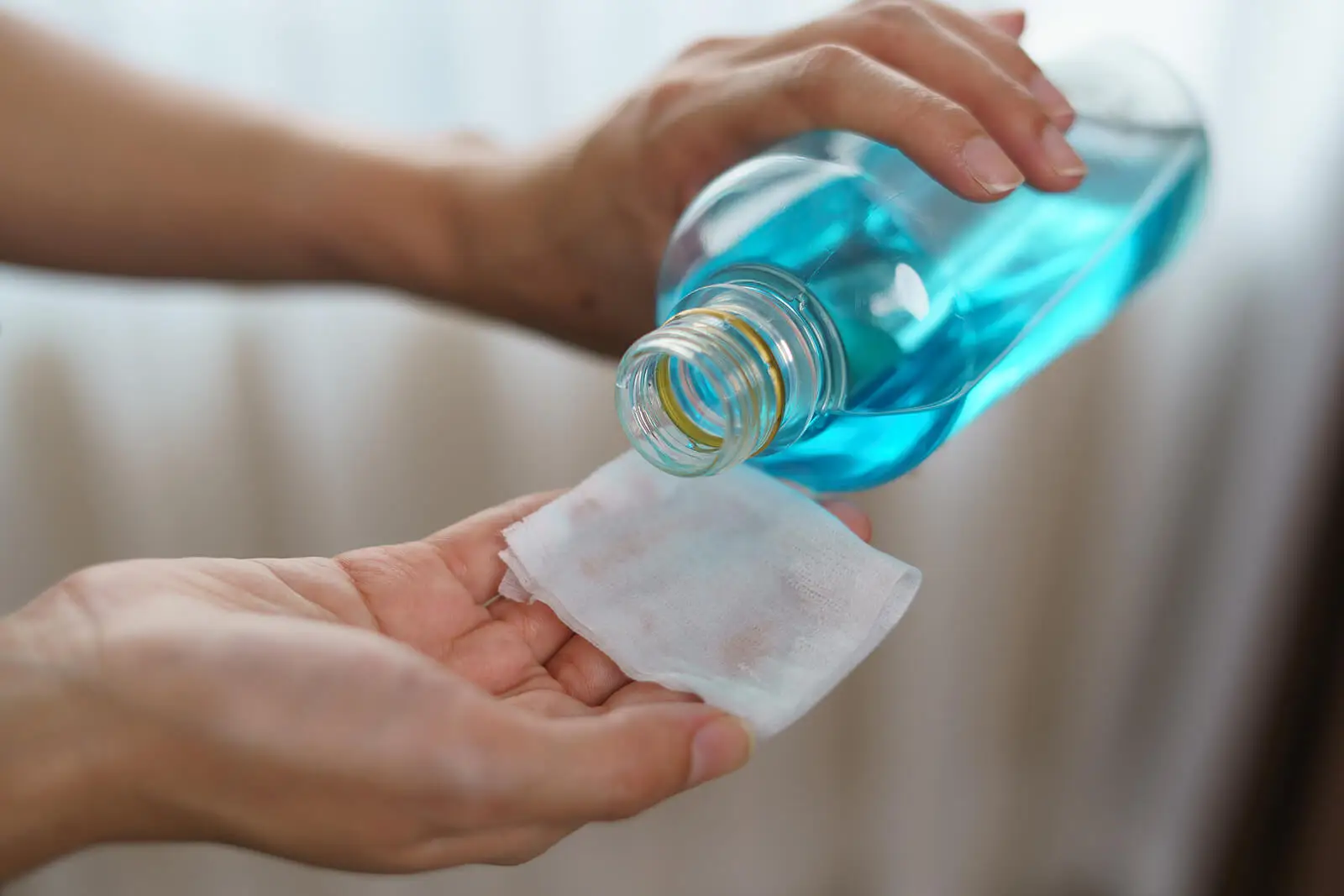Rubbing Alcohol: What Is It and What Are its Uses?


Reviewed and approved by the doctor Leonardo Biolatto
Rubbing alcohol is a chemical capable of getting rid of contaminating substances. The product is also known as dimethylcarbinol, 2-propanol, AIP, isopropyl alcohol, or isopropanol. It’s characterized by its rapid evaporation, taking residues with it.
This substance is freely sold in supermarkets, pharmacies, and other stores. The presentation is almost always in bottles of 1 liter or more; sometimes in aerosol and always specifies its concentration higher than 99%.
13 uses of rubbing alcohol
The usefulness of isopropanol spreads to industrial processes and sanitary routines. For household cleaning and some appliances, it’s common to opt for this type of alcohol. We tell you in which activities to use it.
1. Pest extermination
You can immerse or spray isopropanol on objects that are in contact with parasites or insects – for example, pet collars or combs. The disinfectant effect kills some bacteria and viruses.
2. Maintenance of electronic and computer parts
Computer equipment consists of tiny, delicate parts that require thorough cleaning. Given its cleaning and solvent power, it’s preferable to use isopropyl alcohol. As it evaporates, it leaves no residue and isn’t as volatile, and so it doesn’t damage parts.
The same applies to other electronics. Use a cloth dampened with isopropanol to clean LCD screens, 3D printers, optical disc drives, tablets, CD players, and video game consoles.
Dirt accumulates on frequently used devices such as smartphones. According to a study in a hospital setting, published by the Journal of Occupational and Environmental Hygiene, cell phones are potential channels for bacteria and should be disinfected with alcohol wipes.

3. Elimination of bad odors
Apart from sterilizing, this kind of alcohol eliminates bad odors. Spray some inside shoes and notice how the smell changes.
4. Washing tiles and blinds
Rubbing alcohol is efficient in removing mildew from tiles and dust accumulation on blinds. However, it isn’t recommended for every type of wall or floor.
With tiles, blackened joints, and marble or natural wood floors, white vinegar is better.
5. Removing stains
Paint, ink, or acrylic marks on fabrics come out with isopropanol. Spread and rub some of the liquid to remove the stain.
6. Melt ice off the car
In winter, cars left outside the garage wake up covered in ice. One way to thaw quickly is to pour isopropyl alcohol.
You might be interested in: Tips for Cleaning the Bathroom Effectively
7. Polishing jewelry
2-propanol is a quintessential polish for silver, gold, and other metals. Fill a container with the substance and soak the dirty jewelry for 5 minutes. Then dry the jewelry with a cloth.
8. Washing windows
Rubbing alcohol is a good ally for washing window panes and mirrors.
9. Tool care
In workshops, the properties of rubbing alcohol are used to remove grease and oil from tools. It’s also used to prepare surfaces for welding.
10. Disinfection of the house
Apart from sanitizing floors, walls, and windows, rubbing alcohol disinfects furniture, clothes, and household appliances. It’s also less toxic than other chemicals.
11. In pharmaceuticals and cosmetics
In menthol-based masks and astringents, diluted isopropanol is likely to be found. The alcohol structure reduces the thickness of some liquids and prevents foaming when shaken.
12. Biological preservative
In laboratories, 70-99 % 2-propanol is used to preserve biological samples as an alternative to formaldehyde.
13. In the industrial sector
In industry, isopropyl alcohol is used as a solvent for gums and acrylic resins. It’s an additive in the extraction and purification of different products.
The automotive industry uses this alcohol to solubilize water in gasoline tanks and prevent it from freezing.
How to use cleaning alcohol?
When diluted, rubbing alcohol is not irritating. Otherwise, it’s best to apply it while wearing gloves.
To spread the liquid, wet and rub with a lint-free cotton cloth. It’s also useful to apply the spray and dry with a cloth or kitchen towel.

Precautions when using rubbing alcohol
Handling isopropyl alcohol requires care. The main thing is to respect the warnings and indications on the label.
The following are safety recommendations when using the product:
- Keep alcohol containers closed and away from children and pets, in a cool place.
- Don’t inhale the vapors produced by the substance, for risk of headaches and lung damage. Don’t ingest either, as it’s toxic.
- Disconnect appliances from electricity before cleaning them. If they have been used recently, wait for them to cool down. After cleaning, wait for them to dry before turning them on again.
- Avoid contact with the eyes.
- Never use it in hot rooms or near fire, as it’s flammable.
- Apply it in well-ventilated areas, whether or not you have sensitive skin.
Difference between isopropyl alcohol and ethyl alcohol
Isopropyl alcohol isn’t the same as ethyl alcohol or alcohol 96, which is based on ethanol. While the cleaning alcohol is for domestic use, ethyl alcohol disinfects shallow wounds, is bactericidal, antiseptic and an intermediate in chemical reactions.
The composition of both products is different, and wrong use can cause damage. When buying alcohol for household cleaning, check with the salesperson and the seller to make sure you purchase the correct one.
All cited sources were thoroughly reviewed by our team to ensure their quality, reliability, currency, and validity. The bibliography of this article was considered reliable and of academic or scientific accuracy.
- Brain T, Foong Y, Green M, Ogden K, Siddique R, Tan R, Zargari A. Los teléfonos móviles como potencial vehículo de infección en un entorno hospitalario. Journal of Ocupational and Environmental Hyigiene. 2021. https://www.mendeley.com/catalogue/ce4f74af-945b-3c19-8b84-91d5c5c111ef/?utm_source=desktop&utm_medium=1.19.4&utm_campaign=open_catalog&userDocumentId=%7Bcc711e5f-42af-47a1-aa7f-c8306e5cae73%7D
- Etanol. Chemical Safety Facts.org https://www.chemicalsafetyfacts.org/es/etanol/
- Formaldehído. Chemical Safety Facts.org https://www.chemicalsafetyfacts.org/es/formaldehido/
This text is provided for informational purposes only and does not replace consultation with a professional. If in doubt, consult your specialist.








